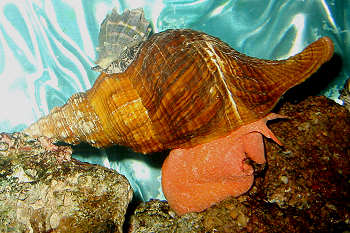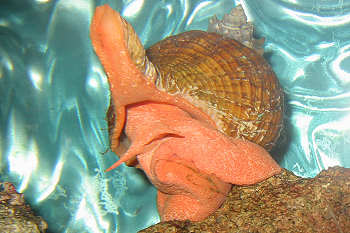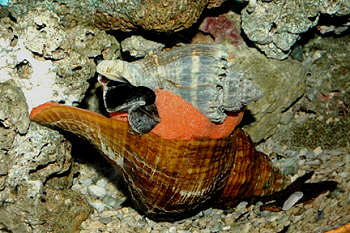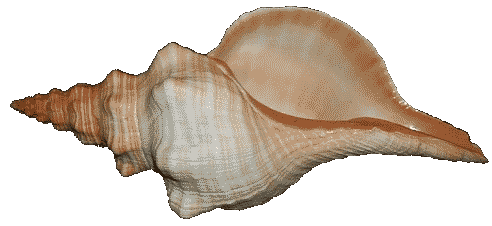|
|
| |
|
A Horse Conch
Tale
By Carolyn Petrikin
|
| |
|
|
|
|
|
Our 30 gallon home aquarium has been
home to a specimen of the
Florida State Shell, Triplofusus giganteus, a brownish
Horse Conch, since July, 2005. We found this mollusc with the
gorgeous bright orange animal near Dunedin, Florida one evening
on a very low summer tide among some exposed grass. At the time
I wondered if it might be a bit too large for our tank! Over
the past fourteen months, he’s become so fascinating to watch
we’ve not returned it back to the bay.
How I wish we had measured the shell!
My guess is that a little over a year ago it was approximately
5 1/2 inches long and 6 1/2 inches around at the largest part.
|

"Horse Conch Looking For His Dinner!"
a Melongena corona is riding on the back of the shell that was
to devour it someday after the photo was taken!!
January, 2006
|
|
|
|
 |
Now, fifteen months later, it’s
a whopper in comparison at 7 1/2 inches long, and 9 3/8 inches
around! But what impresses me more than anything about this shell
is how heavy it has become! I picked it up for the first time
just recently since placing it in our tank and was immediately
shocked to realize this was no longer a “little” shell!
Why is this shell so heavy? Well,
this Horse Conch really has an appetite!
|
|
| |
|
We can keep very little else in the aquarium,
as other molluscs eventually become part of his diet. There was a True
Tulip, Fasciolaria tulipa, already living in the aquarium when
the Horse Conch arrived. The True Tulip is about 4 inches long, and
for some unknown reason, has never been approached by the Horse Conch!
But not so for other residents in the aquarium!
|
| |
|
I wish I had kept a log from the very beginning,
but only began noticing the huge number and variety of molluscs consumed
by this fellow earlier this year. Our Horse Conch has devoured approximately:
- twenty-five
King’s Crowns—Melongena corona
- five
or six Florida Fighting Conchs—Strombus alatus
- several
Banded Tulips—Fasciolaria lilium hunteria
- two
Say’s Pear Whelks—Busycon spiratum pyruloides
- five
small Lightning Whelks—Busycon contrarium
- numerous
Eastern Nassas—Nassarius vibex
- tiny
Oyster Drills—Urosalpinx tampaensis
- Marsh
Periwinkles—Littorina irrorata
- several
Common American Augers---Terebra dislocata
- Cross-barred
Venus Clams—Chione cancellata
- many
Lettered Olives—Oliva sayana
- Moon
Snails—Neverita duplicata
|
Oh yes, there have been
many other tasty treats for this guy as well.
|
| |
|
Then there were the half dozen
Spruce Creek Melongenas—
Melongena sprucecreekensis gathered south of Daytona Beach
at Spruce Creek in July. By the middle of September, all six
shells were empty! Believe me—this is really a nifty way to clean
your shells!! To show that this ravenous mollusc is not a terribly
picky eater, three of the invasive species of Asian Green Mussels---Perna
viridis have also gone his way.
These are the molluscs on Horse
Conch’s menu I’m able to recall. There’s really no telling what
might become the next part of his diet! I’m wondering-----you
don’t suppose that it just might be that True Tulip??
|

the Horse Conch just beginning to eat the last of my 6 Spruce
Creek Melongenas, Melongena sprucecreekensis. A portion
of the Melongena animal still shows in the picture. - September
, 2006
|
|
| |
| |
| |
<bgsound src="cockles.mid" loop=infinite></b></font>
<p><font face="Arial, Helvetica, sans-serif"><b>
Free
Counters
|



